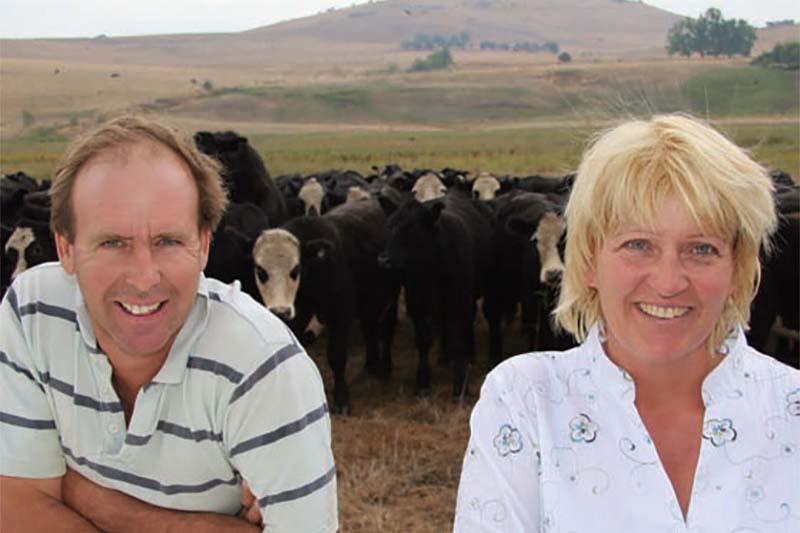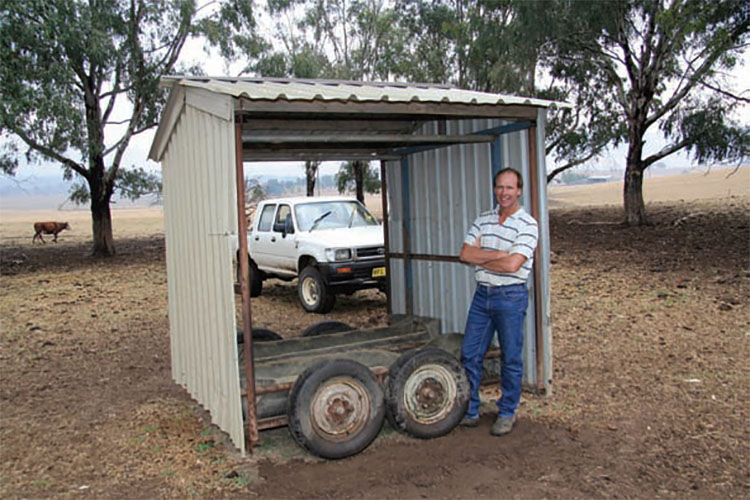
Case
Study
Location
Tooma, New South Wales
Crop
Pasture
Bond Family, ‘Wyandra’ Tooma NSW
Upper Murray graziers Jamie and Virginia Bond have lifted total beef production by nearly 30 per cent over the past decade via a concerted effort to improve their pasture efficiency and livestock husbandry.
The couple run 500 Angus and black baldy cows on their 783 ha property, ‘Wyandra’, Tooma. When the Bonds purchased the property from Virginia’s parents 11 years ago, they realised that they faced a bleak future unless they changed their management.
At the time, the property was subdivided into a network of 40 ha paddocks. The soils were in poor condition and there were few perennial pastures. Grass tetany was a huge problem among the autumn-calving herd and there was often insufficient feed during winter.
With a background in dairy farming and a cell grazing course under his belt, Jamie believed that rotational grazing could deliver much better pasture management, feed utilisation and weed control.
He dismantled the existing fencing and created 60 new 11ha paddocks in the hill country and 28 new 4.5 ha paddocks on the river flats using electric fencing. Each group of paddocks radiates out from a central concrete water trough, which is gravity-fed via poly pipe from a series of dams, each of which has been fenced off to keep the water clear and clean.

Jamie and Virginia Bond from ‘Wyandra’ cattle farm Tooma NSW.

Jamie Bond with his portable covered stock lick.
“We didn’t have any money for fertiliser but straight away the new paddocks helped us to grow more grass,” Virginia said. “Having more paddocks means we are able to build up a supply of grass through the winter for the cows to calve onto, and calf marking and handling became much quicker and easier.”
Depending on the amount of pasture growth, cattle spend one to three days in each paddock before being moved.
The only exception is at calving, when several paddocks are opened up to allow the cows to spread out. Coupled with the pasture program has been a switch to spring calving to make the most of the spring ‘flush’ and reduce the need for winter feeding. According to Jamie, the move has also been profitable in its own right.
“We used to sell the autumn-drop calves as weaners in Corryong and we weren’t getting much money for them,” he said. “When we went across to spring calving in 1998, we were able to grow the steers out to feedlot weights and make $550 a head instead of $350.”
When the Bonds purchased the property from Virginia’s parents 11 years ago, they realised that they faced a bleak future unless they changed their management.
When the Bonds were able to spread superphosphate, they watched in anguish as their cattle bloated. “That’s when we decided we needed to get into something different,” Virginia said.
A friend put them onto BioAg. After ‘dabbling’ with various BioAg products for a few years, the Bonds signed up for a BioAg Fertility Program tailored to their property. The program incorporated a range of BioAg solid, liquid nutrients and conventional inputs, including BioAgPhos.
Lacking the resources to implement the program across the whole farm, the Bonds decided to progressively treat every second paddock and those paddocks nearest their stockyards to create a network of ‘bloat safe’ paddocks.
Each autumn, they apply 100kg per ha of BioAgPhos and 450kg per ha of lime using a belt spreader. This is followed by a foliar application of 2-3L per ha of BioAg Soil & Seed™ in August and then 2L per ha of Balance & Grow®, along with trace elements, such as molybdenum, zinc and boron, in September.
The third year’s program included 100kg per ha of BioAgPhos, 300kg per ha of lime and 150kg per ha of gypsum applied in autumn and 2L per ha of Soil & Seed at the autumn break and again in late winter.
Coupled with the pasture program has been a switch to spring calving to make the most of the spring ‘flush’ and reduce the need for winter feeding.
The Bonds have noticed a significant improvement in livestock health since adopting the new soil nutritional program, with grass tetany eliminated and bloat under control. “We didn’t lose any cattle to bloat last year so we know we’re heading in the right direction,” Virginia said.
To further assist with bloat control, Soil & Seed is added to the cattle’s drinking water. Cattle also have access to a lick containing BioAgPhos, Soil & Seed, dolomite, rock dust (a blend of non-plant food ingredients, granite and limestone), copper sulphate, zinc sulphate, diatomaceous earth (a fine but sharply abrasive powder made from crushed fossils of tiny marine organisms that help to control internal parasites), sulphur, molasses and salt.
The lick is fed out in a weatherproof feeder, which is moved as the cattle are rotated from paddock to paddock. “The lick gives the cattle any minerals that might be lacking in the soil, as well as increasing microbial activity in the rumen,” Jamie said.
The wide-ranging changes at ‘Wyandra’ are beginning to pay handsome financial dividends, with total beef production on a per kilogram basis increasing almost 30 percent since 1996. The Bonds now turn off about 250 steers a year, aiming for a feedlot entry weight of 450kg. The heifers are kept as replacement breeders or sold as weaners.
The wide-ranging changes at ‘Wyandra’ are beginning to pay handsome financial dividends, with total beef production on a per kilogram basis increasing almost 30 percent since 1996.
The Bonds are now replacing their native pastures with phalaris, perennial ryegrass, Haifa white clover and possibly some lucerne. “In the past lucerne would have been out of the question but with the BioAg program, we are reasonably confident of being able to avoid bloat problems,” Jamie said.
“It’s too early to say for sure, but we think the BioAg program is starting to break down a hard pan just below the soil surface. We use an aerator to break it up enough to get the nutrients, microbes and oxygen down into the soil, and nature does the rest.”
While Jamie said it was too early to comment on the benefits of the BioAg program in terms of improving soil structure, Virginia is convinced of its potential benefits. “I applied the full BioAg program on my vegetable garden and within six months it had turned into beautiful soil that was chock-a-block full of worms,” she said.
Download case study
Download a PDF version of the above case study.

Recent Comments